Whoosh, whoosh, whoosh, sang the wind as it rushed down from the snowy mountains. It zoomed over the hills, humming and whistling through the tall trees. Haunted Hill didn’t have much to stop the wind – just some small trees and bushes, and the broken walls of an old town.
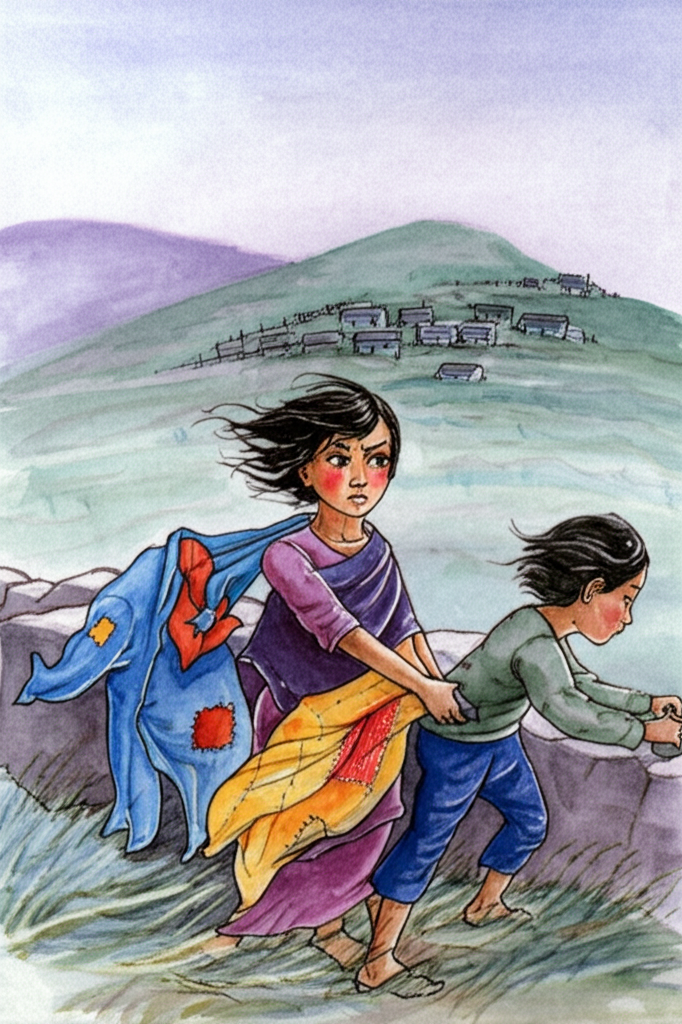
On the next hill was a village. People put big rocks on their roofs to keep them from flying away. It was almost always windy there. Three kids were putting clothes out to dry on a short stone wall, with a rock on each piece.
Usha, who was eleven and had dark hair and rosy cheeks, was trying to hold down her grandpa’s big, loose shirt. Her little brother, Suresh, who was eight, was holding onto a bedsheet, and their friend Binya, who was a little older than Usha, was helping too.
Once the clothes were safe with the rocks, they climbed onto the flat rocks and sat in the sun, looking at the broken buildings on Haunted Hill.
‘I need to go to the shops today,’ said Usha.
‘I wish I could go!’ said Binya. ‘But I have to help with the cows.’
‘I can go!’ said Suresh. He always wanted to go to the shops, which were far away, on the other side of the hill.
‘No, you can’t,’ said Usha. ‘You need to help Grandpa chop wood.’
‘Won’t you be scared walking back alone?’ he asked. ‘There are ghosts on Haunted Hill!’
‘I’ll be back before it gets dark. Ghosts don’t come out during the day.’
‘Are there lots of ghosts in the old buildings?’ asked Binya.
‘Grandpa says so. He says that a long, long time ago, some people from another country lived on the hill. But lightning kept hitting the town, so they left.’
‘But if they left, why are there ghosts there?’
‘Because – Grandpa says – during a really bad storm, lightning hit one of the houses, and everyone inside died. Even the children.’
‘How many children?’
‘Two. A boy and his sister. Grandpa saw them playing there when the moon was out.’
‘Was he scared?’
‘No. Old people aren’t afraid of ghosts.’
Usha started walking to the shops at two o’clock in the afternoon. It took about an hour. The path went through fields of yellow flowers, then along the top of the hill, and right through the broken buildings. Usha had gone that way lots of times to buy things or visit her aunt, who lived in the town nearby.
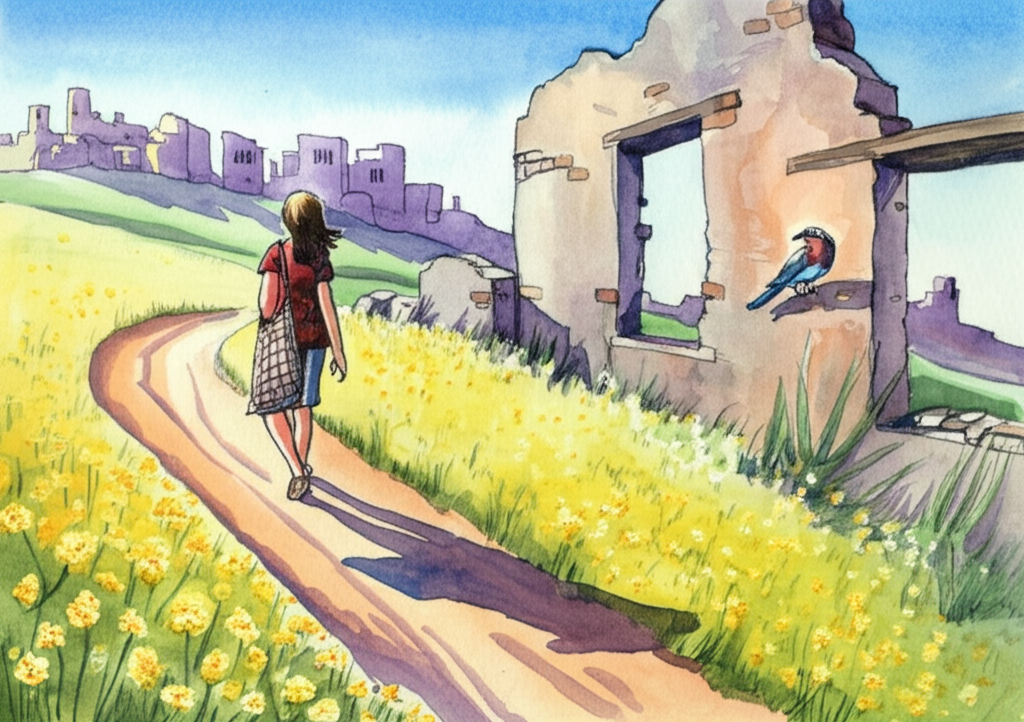
Wild flowers grew on the broken walls, and a wild plum tree was growing right out of the floor of what used to be a room. It was covered in pretty white flowers. Little lizards ran over the rocks, and a bird with shiny purple feathers sat on a window and sang a beautiful song.
Usha sang too, as she skipped along the path, which went down to the valley and to the little town with its busy shops.
Usha bought spices, sugar, and matches. With the money she had saved, she bought a necklace of yellow beads for herself and some marbles for Suresh. Then she got her mom’s shoes fixed at the shoe shop.
After that, Usha visited her Aunt Lakshmi in her apartment above the shops. They were talking and drinking hot tea when Usha saw that dark clouds were gathering over the mountains. She quickly grabbed her things, said goodbye to her aunt, and started walking back to the village.
It was strange, but the wind had stopped. The trees weren’t moving, and the crickets were quiet. The crows were flying in circles, then they landed on a tree.
‘I need to get home before dark,’ thought Usha, hurrying along the path.
But the sky got darker, and a loud rumble echoed over the hills. Usha felt the first raindrop hit her cheek. Holding her shopping bag close, she walked faster and faster. The raindrops were coming down harder now – cold, stinging raindrops. Lightning flashed, showing the broken buildings on the hill, and then it was dark again. It was nighttime!
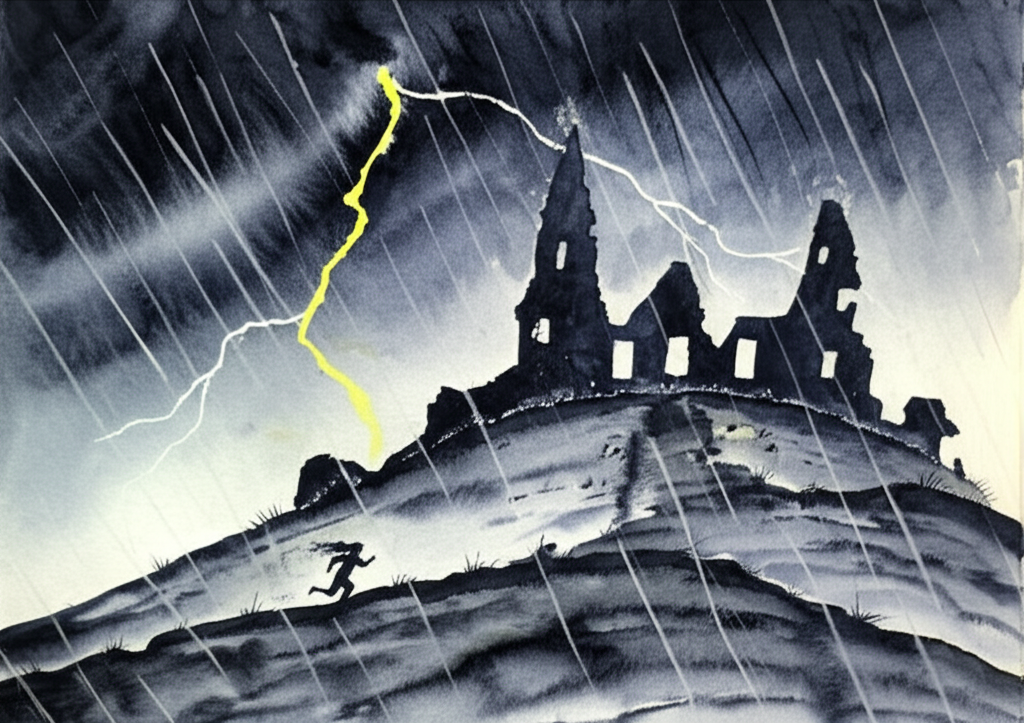
‘I need to find shelter in the ruins,’ Usha thought, and she started to run. Suddenly, the wind started blowing again, but she didn’t have to fight it. It was behind her now, helping her up the steep path to the top of the hill. There was another flash of lightning, and then thunder. The broken buildings looked scary in front of her.
Usha remembered an old piece of roof that would give her some shelter. It would be better than trying to keep going. In the dark, with the wind, she might fall off the path and over the edge of the hill.
Whoosh, whoosh, whoosh, howled the wind. Usha saw the wild plum tree bending over, its branches hitting the ground. She found her way into the ruins, with the help of the lightning. Usha put her hands on a stone wall and moved carefully, trying to reach the sheltered corner. Suddenly, her hand touched something soft and furry, and she shouted in surprise. Her shout was answered by another – a mix of growl and screech – as something jumped away in the darkness.
Usha was relieved to see that it was just the cat that lived in the ruins. She had been scared for a moment, but now she moved quickly along the wall until she heard the rain hitting the old roof. Crouched in a corner, she found some shelter. But the roof creaked and rattled like it was going to fly away.
Usha remembered that across the empty room was an old fireplace. Maybe it would be drier there, under the chimney. But she didn’t want to try to find it right now – she might get lost.
Her clothes were soaking wet, and water dripped from her hair, making a puddle at her feet. She thought she heard a soft cry – was it the cat again, or an owl? Then the storm drowned out all the other sounds.
She hadn’t had time to think about ghosts, but now that she was safe in one place, Usha remembered Grandpa’s story about the ruins being hit by lightning. She hoped and prayed that lightning wouldn’t hit her.
Thunder crashed over the hills, and the lightning flashed more often. Then there was a big flash, and for a moment the whole ruin lit up. A blue streak zipped along the floor of the building. Usha was looking straight ahead, and when the opposite wall lit up, she saw two small figures crouching in front of the unused fireplace – children!
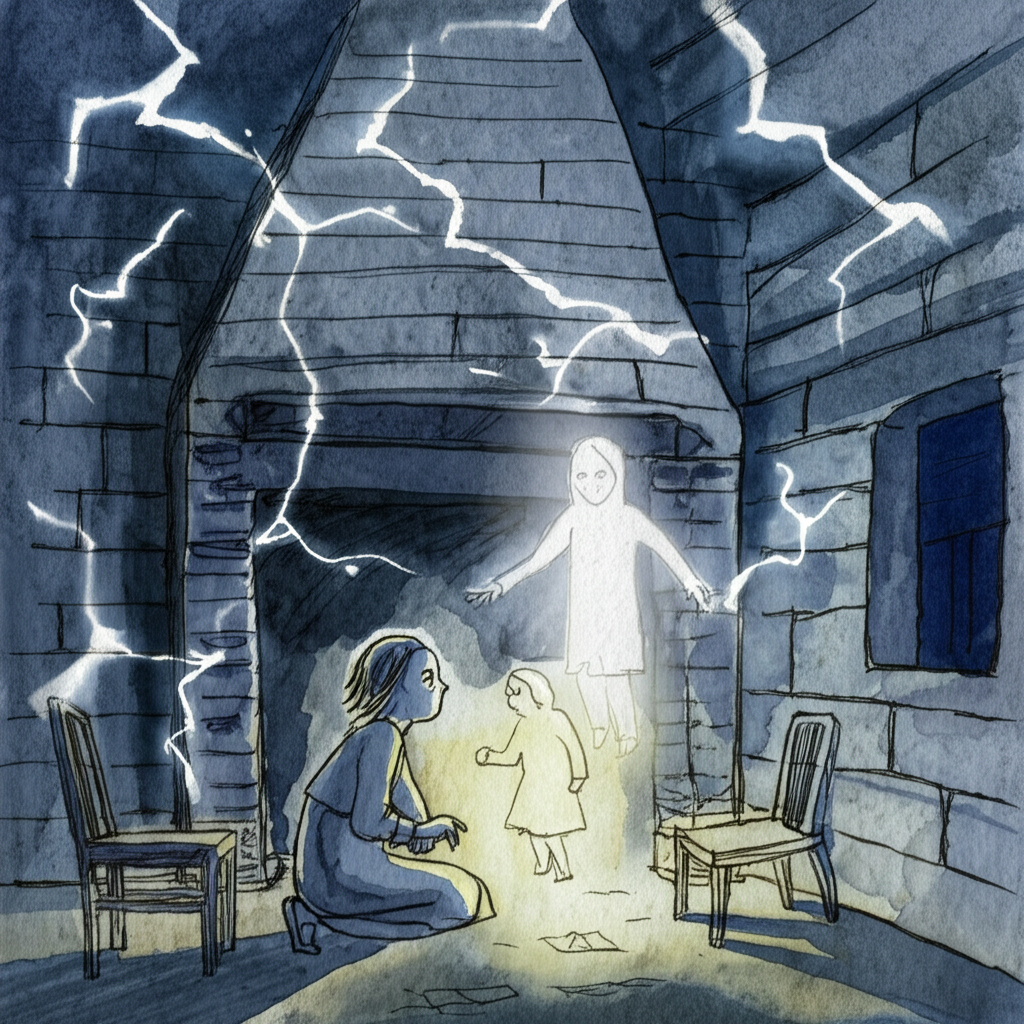
The ghostly figures seemed to look up and stare back at Usha. And then everything was dark again.
Usha’s heart was pounding. She had definitely seen two ghosts on the other side of the room. She didn’t want to stay in the ruins for even one more minute.
She ran towards the big hole in the wall where she had come in. She was halfway across the open space when something – someone – bumped into her. Usha tripped, got up, and bumped into something again. She screamed.
Someone else screamed. And then there was a shout, a boy’s shout, and Usha knew the voice right away.
‘Suresh!’
‘Usha!’
‘Binya!’
They hugged each other, so surprised and happy that they could only laugh and say each other’s names.
Then Usha said, ‘I thought you were ghosts.’
‘We thought you were a ghost,’ said Suresh.
‘Let’s go back under the roof,’ said Usha.
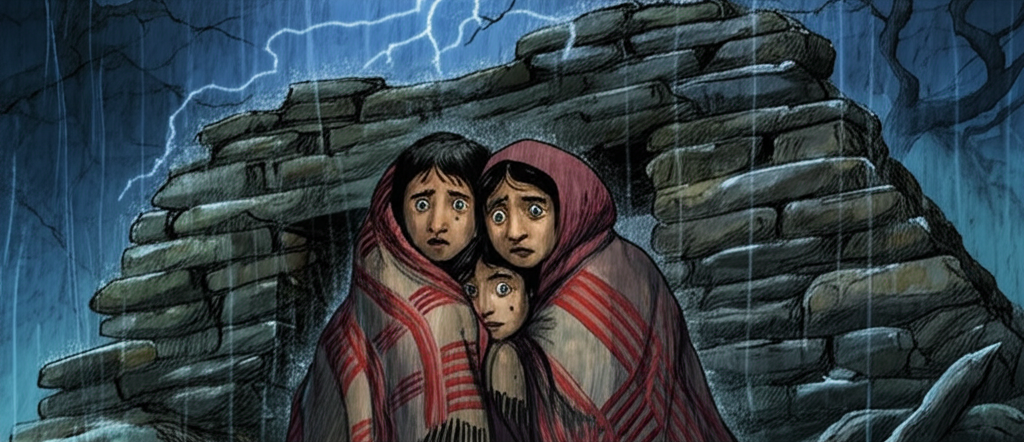
They huddled together in the corner, talking excitedly. ‘When it got dark, we came looking for you,’ said Binya. ‘And then the storm started.’
‘Should we run back together?’ asked Usha. ‘I don’t want to stay here any longer.’
‘We have to wait,’ said Binya. ‘The path has been washed away in one place. It’s not safe in the dark, in all this rain.’
‘We’ll have to wait until morning,’ said Suresh, ‘and I’m so hungry!’
The storm continued, but they weren’t afraid now. They kept each other warm and gave each other courage. Even the ruins didn’t seem so scary.
After an hour, the rain stopped, and the thunder got quieter.
As it started to get light, the bird began to sing. Its sweet song filled the ruins with music. As the sky got brighter, they saw that the plum tree was standing up again, even though it had lost all its flowers.
‘Let’s go,’ said Usha.
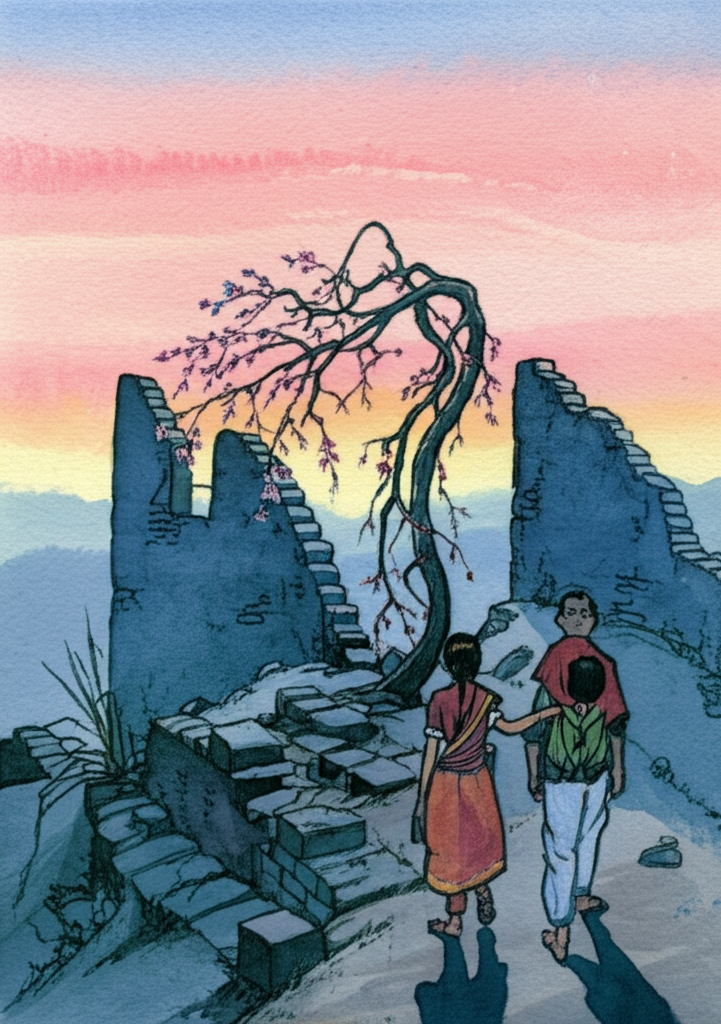
Outside the ruins, walking along the top of the hill, they watched the sky turn pink. When they were far away, Usha looked back and said, ‘Can you see something behind the wall? It looks like a hand waving.’
‘It’s just the top of the plum tree,’ said Binya.
‘Goodbye, goodbye…’ They heard voices.
‘Who said “goodbye”?’ asked Usha.
‘Not me,’ said Suresh.
‘Me neither,’ said Binya.
‘I heard someone calling,’ said Usha.
‘It’s just the wind,’ said Binya.
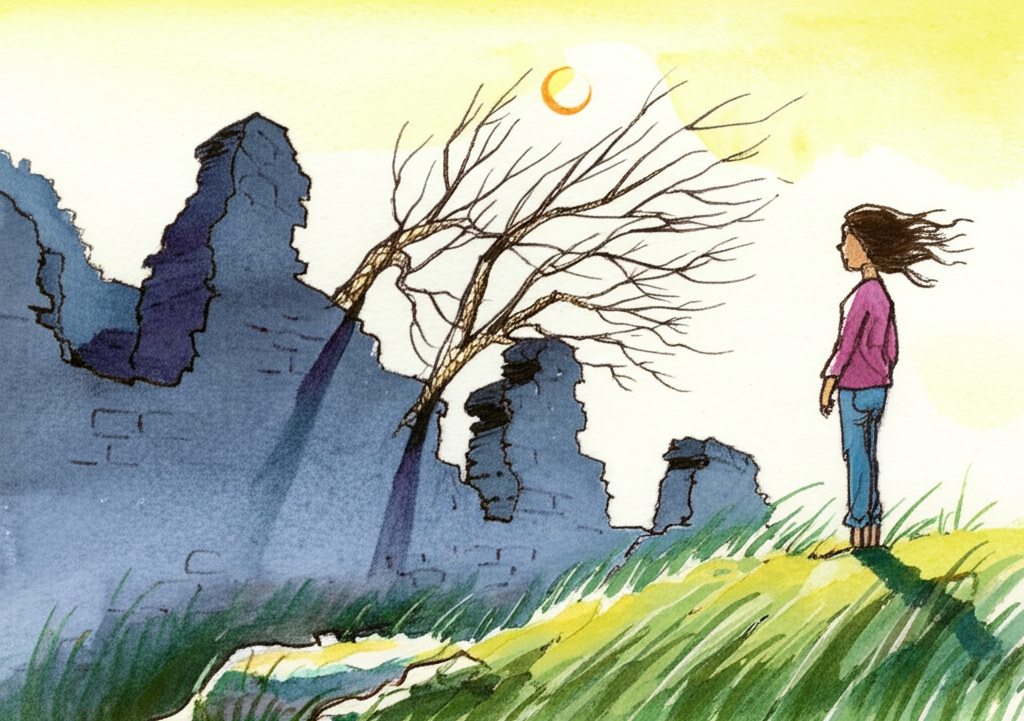
Usha looked back at the ruins. The sun had come up and was shining on the top of the wall.
‘Come on,’ said Suresh. ‘I’m hungry.’
They hurried along the path to the village.
‘Goodbye, goodbye…’ Usha heard them calling. Or was it just the wind?